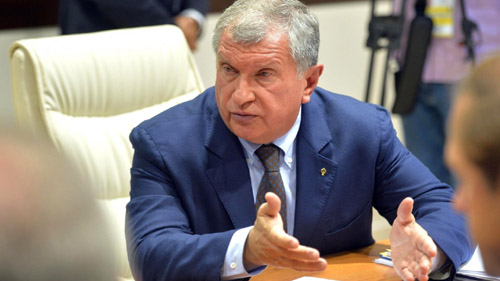FPI / March 13, 2020
By Paul Crespo
Russia and Saudi Arabia are now engaged in a full-scale oil price war where the ultimate target is the U.S. shale oil industry. Russia provoked this war days ago when it refused to follow OPEC+ plans to decrease production to maintain prices as the coronavirus saps demand.
OPEC+ is a group of 24 oil-producing nations, made up of the 14 members of the Organization of Petroleum Exporting Countries (OPEC) led by Saudi Arabia, plus 10 other non-OPEC members, led by Russia, but not including countries such as Venezuela or the U.S. This oil war has cut the price of crude by 30 percent in just a few days, affecting the oil and stock markets in U.S.

The Saudi demands for more production cuts were opposed by Russia, largely because the say prices raises only aid the U.S oil and gas shale industry — with its high-cost deposits which require expensive fracking and other means to produce. According to Forbes, Saudi Arabia then went for the oil world’s “nuclear option,” and fired the first salvo by opening the “spigots to dramatically increase production, backed up with discounts to major customers which led to the inevitable oil-price crash.”
“By Saudi Arabia actually now declaring war, they are front-running the Russians in declaring war on U.S. shale,” Johannes Benigni, chairman and founder of JBC Energy Group, told CNBC on Monday.
There is more to this story, however. Russia is also seen to be retaliating against U.S. sanctions against Russia last year, and more recent sanctions this year against a subsidiary of Russian oil conglomerate Rosneft for its support of the illegitimate Maduro regime in Venezuela. Last year Russian president Vladimir Putin warned that Russia would retaliate at a time and place of its own choosing.
RBC Capital Markets analyst Helima Croft was reported by Barron’s as blaming Igor Sechin, the chief executive of Russia’s Rosneft Oil and formerly from Russia’s intelligence services, “By triggering a price war in which Russia and the Saudis will flood the world with cheap crude, Sechin hopes to damage the shale-oil producers that have made the U.S. energy independent,” Croft has been told. He is also retaliating against the recent U.S. sanctions over Venezuela.
The U.S. has also been encouraging Europeans to buy more energy produced from North American sources, including the shale energy sector, as part of a broader strategy to compete with Russia for energy markets and to constrain Moscow’s energy export revenues. Russia is now pushing back. The question is whether this strategy will work.
As described by Nikolas K. Gvosdev in The National Interest, “Wrecking the OPEC-Plus arrangement and provoking a demolition-derby price war with Saudi Arabia may seem to be an odd and puzzling way to respond, but there may be a method to that madness. I believe that the Kremlin is gambling that, by year’s end, it will be able to not only push back against the United States but also to reconstruct its partnership with Saudi Arabia.”
As Forbes notes, the irony is that Saudi Arabia has tried the market flooding technique before in an attempt to crush U.S. shale production and failed. “Russia must also know that the result of this latest oil flood will be to dry up U.S. shale output, but it will come back as soon as the oil price recovers. In the meantime, both the Russian and Saudi economies are likely to be damaged, as will the economies of other oil-dependent countries — but not the U.S.”
However, as reported by CNBC, “Russia has a flexible currency while Saudi’s riyal is pegged to the U.S. dollar,” Chris Weafer, a senior partner at Macro-Advisory, said in a research note. “It means that Moscow is unlikely to blink first, certainly not for another 3 to 6 months. But Moscow may take the view that Saudi Arabia’s financial position will be a lot more strained before that.”
“The big target for both may be the marginal U.S. shale producers,” Weafer said. The Financial Times notes that “U.S. shale producers, dependent on high prices and the goodwill of investors to fund a business model that requires constant spending, have been huge beneficiaries of Russia’s co-operation with OPEC in the past four years.”
“The U.S. shale sector was struggling even before this week’s oil-price collapse with mounting debts, unhappy investors, rising bankruptcy risks and the prospect of slowing output growth.” The Financial Times reports. That means “U.S. shale will start to show the strain even if prices remain depressed for just six to 12 months,” analysts said.
FT added that U.S. oil executives have lobbied President Trump to extend financial aid to shale producers, but their business model depended on Russian and Saudi support for oil prices, and Moscow just ended that cooperation.
Long term, neither Saudi Arabia nor Russia can fight an oil war for long before it causes financial stress. But the Gulf Cooperation Council (GCC) has “substantial” foreign currency reserves, Ryan Lemand, senior executive officer at ADS Investment Solutions said Monday on CNBC’s Capital Connection, “putting countries in the Middle East at an advantage when it comes to withstanding a period of lower oil prices.
“It [GCC] can sustain one year (or) two years of a strategy like that. Others cannot. I think Russia will not sustain this for much longer and I think Russia will come back to OPEC+ just like it did previously a few years ago,” Lemand said.
The U.S., with its revitalized oil industry, might suffer short-term damage in the shale sector, as noted by Forbes, but could ultimately emerge as a winner because cheap oil benefits its deeper and more diverse economy.
Paul Crespo is CEO at SPECTRE Global Risk [http://www.spectreglobalrisk.com/] and Washington Editor of the Free Press Media Group [http://freepressmediagroup.com/]
Intelligence Brief __________ Replace The Media
